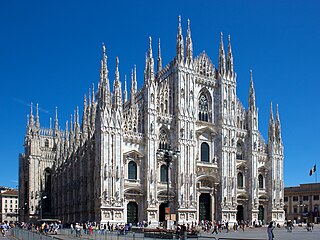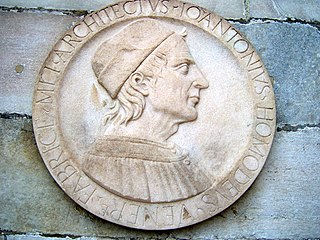Pietro Antonio Daverio | |
|---|---|
| Born | 1564 |
| Died | 1621 or 1622 |
| Known for | Sculptor |
| Spouse | Margherita Brambilla |
Pietro Antonio Daverio (Milan, 1564 - Milan, 1621-1622) was an Italian sculptor.

Pietro Antonio Daverio | |
|---|---|
| Born | 1564 |
| Died | 1621 or 1622 |
| Known for | Sculptor |
| Spouse | Margherita Brambilla |
Pietro Antonio Daverio (Milan, 1564 - Milan, 1621-1622) was an Italian sculptor.

Very little is known about his early life. He might have been born in the basilica of San Babila in Milan in 1564. He was a pupil of Francesco Brambilla whose daughter Margherita he married [1] and by whom he had more children, his sister Vittoria married the painter Aeneas Salmeggia.
His activity as a sculptor is documented from 1588 on the Annals of the factory of the cathedral of Milan with a payment To magistro Pietro Antonio Daverio , qual ha finito la statua di s. Gervasio incominciata dal Padoano , qual è morto avanti il finimento di essa, 1. 180. given the lack of information about his apprenticeship, it is assumed that the sculptor had his artistic training precisely in the great construction site of the Milan Cathedral, where he is reported to have been present until 1619, producing many works.
His ability to finish and interpret the works of other sculptors more renowned than him including Francesco Brambilla, led him to always be a minor part of the Milanese factory. In 1595 he was commissioned to make a bust representing Charles Borromeo for the Maggiore hospital in Milan, the bust was made in 1603, the work is sober but well executed, although the subject was depicted several times, and it was obligatory to make a likeness portrait of him, he knew how to give it originality by animating the cope and the bishop's mitre with decorative details [2] .
A few years later, he was commissioned to make a bust of Francesco Sforza, for which there is evidence of a payment of 180 lire in 1606. The subject was identifiable only on iconographic documentation and not from a direct source, but Daverio managed to give a correct image of him, enclosed in his embroidered armor enclosed within a cloak knotted on his shoulders, his face with a sweet expression is furrowed by the wrinkles of age that weigh down his features. The bust was saved from the bombing during World War II. [3]
He always remained faithful to his late Mannerist training by Brambilla, and although he became Gian Andrea Biffi's comprimario for the creation of the statue of the Pieta to be placed on the funeral monument of Pellegrino Tibaldi, he never allowed himself to be influenced by the more restless style of the young Milanese [4]
The last commissions appear to be two statues depicting a saint Cancianilla and a saint Pelagia, again from the annals it appears that payment for this last work was collected by his son Charles after his death at the turn of 1621-1622.

Francesco I Sforza was an Italian condottiero who founded the Sforza dynasty in the duchy of Milan, ruling as its (fourth) duke from 1450 until his death. In the 1420s, he participated in the War of L'Aquila and in the 1430s fought for the Papal States and Milan against Venice. Once war between Milan and Venice ended in 1441 under mediation by Sforza, he successfully invaded southern Italy alongside René of Anjou, pretender to the throne of Naples, and after that returned to Milan. He was instrumental in the Treaty of Lodi (1454) which ensured peace in the Italian realms for a time by ensuring a strategic balance of power. He died in 1466 and was succeeded as duke by his son, Galeazzo Maria Sforza. While Sforza was recognized as duke of Milan, his son Ludovico would be the first to have formal investiture under the Holy Roman Empire by Maximilian I in 1494.

Ludovico III Gonzaga of Mantua, known as the Turk, also spelled Lodovico was the ruler of the Italian city of Mantua from 1444 to his death in 1478.

Milan Cathedral, or Metropolitan Cathedral-Basilica of the Nativity of Saint Mary, is the cathedral church of Milan, Lombardy, Italy. Dedicated to the Nativity of St. Mary, it is the seat of the Archbishop of Milan, currently Archbishop Mario Delpini.

Ludovico Maria Sforza, also known as Ludovico il Moro, and called the "arbiter of Italy" by historian Francesco Guicciardini, was an Italian nobleman who ruled as the Duke of Milan from 1494 to 1499.

The Archdiocese of Milan is a Latin Church ecclesiastical territory or archdiocese of the Catholic Church in Italy which covers the areas of Milan, Monza, Lecco and Varese. It has long maintained its own Latin liturgical rite usage, the Ambrosian rite, which is still used in the greater part of the diocesan territory. Among its past archbishops, the better known are Ambrose, Charles Borromeo, Pope Pius XI and Pope Paul VI.

The Golden Ambrosian Republic was a short-lived republic founded in Milan by members of the University of Pavia with popular support, during the first phase of the Milanese War of Succession. With the aid of Francesco Sforza they held out against the forces of the Republic of Venice, but after a betrayal Sforza defected and captured Milan to become Duke himself, abolishing the Republic.

Cassano d'Adda is a town and comune in the Metropolitan City of Milan, Lombardy, Italy, located on the right side of the Adda River. It is on the border of the Metropolitan City of Milan and the province of Bergamo. It is served by Cassano d'Adda railway station.

Giovanni Antonio Amadeo was an Italian Renaissance sculptor of the Early Renaissance, architect, and engineer. He dominated late fifteenth-century Lombard architecture and sculpture.

Federico Borromeo was an Italian cardinal and Archbishop of Milan, a prominent figure of Counter-Reformation in Italy.

The Certosa di Pavia is a monastery and complex in Lombardy, Northern Italy, situated near a small town of the same name in the Province of Pavia, 8 km (5.0 mi) north of Pavia. Built in 1396–1495, it was once located on the border of a large hunting park belonging to the Visconti family of Milan, of which today only scattered parts remain. It is one of the largest monasteries in Italy.

Peschiera Borromeo is a comune (municipality) in the Metropolitan City of Milan in the Italian region Lombardy, located about 12 kilometres (7 mi) southeast of Milan. It received the honorary title of city with a presidential decree on 6 August 1988.

The aristocratic House of Borromeo were merchants in San Miniato around 1300 and became bankers in Milan after 1370. Vitaliano de' Vitaliani, who acquired the name of Borromeo from his uncle Giovanni, became the count of Arona in 1445. His descendants played important roles in the politics of the Duchy of Milan and as cardinals in the Catholic Reformation. In 1916, the head of the family was granted the title Prince of Angera by the King of Italy.

Filippo Abbiati (1640–1715) was an Italian painter of the early-Baroque period, active in Lombardy and Turin, together with Andrea Lanzani and Stefano Maria Legnani, he was a prominent mannerist painters from the School of Lombardy. Born in Milan, he was a pupil of the painter Antonio Busca. Alessandro Magnasco was one of his pupils along with Pietro Maggi and Giuseppe Rivola. Ticozzi claims he trained, along with Federigo Bianchi, with Carlo Francesco Nuvolone. Along with Bianchi, he painted the cupola of Sant'Alessandro Martire in Milan. Abbiati also painted a St. John preaching in the Wilderness for a church in Saronno.

A crown-cardinal was a cardinal protector of a Roman Catholic nation, nominated or funded by a Catholic monarch to serve as their representative within the College of Cardinals and, on occasion, to exercise the right claimed by some monarchs to veto a candidate for election to the papacy. More generally, the term may refer to any cardinal significant as a secular statesman or elevated at the request of a monarch.

Pelagio Palagi was an Italian painter, sculptor and interior decorator.

The Rocca Borromeo di Angera, or Rocca d'Angera, also called Borromeo Castle, is a rocca on a hilltop above the town of Angera in the Province of Varese on the southern shores of Lago Maggiore. It has medieval origins and initially belonged to the Milanese archbishop. It passed then to the Visconti of Milan and later to the Borromeos, who are still the owners.
The Stampa are a well-known family of old Italian nobility that rose to prominence in the 15th century. They were Grandees of Spain, members the Order of the Golden Fleece and owned many estates throughout the Italian Peninsula, including a Castle in Soncino, a Palace in Milan, and countless others in Muggiò, Melzo, Gorgonzola, Rivolta d'Adda, Ferentino and Rome. They are related to some of the most important Italian noble houses, such as the Doria, Sforza, Gonzaga, Borromeo and Visconti.

The Arese are a prominent family of the Milanese nobility.
Fabrizio De Magistris was an Italian sculptor active in Lombardy between 1595 and 1602.